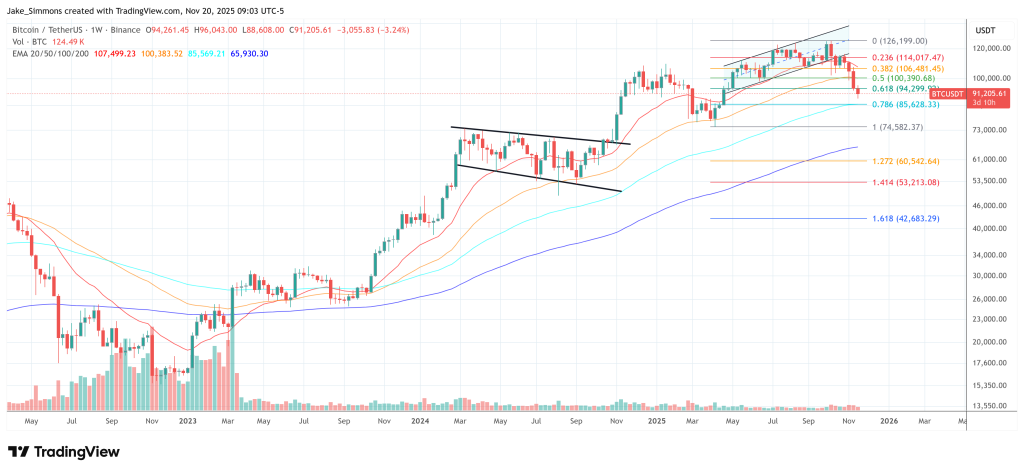Why Bitwise Thinks Bitcoin Still Hits $200,000 In 2026
Ryan Rasmussen, Head of Research at Bitwise, used a Yahoo Finance appearance to restate Bitwise’s view that Bitcoin is headed to $200,000 in 2026, while simultaneously characterizing the current sell-off as a maturing-market shakeout rather than a trend break.
Is The Bottom In For Bitcoin?
He opened with a near-term assessment that “we’re closer to the bottom here today than we have been for the past few weeks,” linking the drawdown to sharply risk-off conditions and to ETF-era flow dynamics. In his framing, Bitcoin “really was a leader of this risk-off move starting in mid-October,” and he expects it to “be a leader to the upside once things start to turn around,” adding that the market feels nearer to that inflection than it did “a week or two weeks ago.”
When asked whether spot Bitcoin ETFs have become a double-edged sword, Rasmussen agreed, describing a market that now has deeper liquidity but more cross-currents. “Bitcoin, in our view, is one of the biggest technological developments of the past 15 years,” he said, before explaining that institutionalization brings “new investors and adds more liquidity to the market,” yet also means “we’re seeing a lot more choppiness in times where risk-off moves happen.”
He pointed to hedge funds rotating in and out via basis trades and emphasized that “you just have more market participants.” Over time, he expects that shift to damp volatility, but not in a straight line: “throughout that journey, we’re going to see some choppiness, and certainly over the past month, we’ve seen that.”
Pressed on why volatility still looks elevated, Rasmussen separated short-horizon spikes from long-run trend. “If you look at the trend over the past 10 years, volatility has certainly been falling,” he said, but conceded that “over this short-term period, you do see spikes in volatility.” The composition of buyers is, in his view, changing in a stabilizing direction. “The buyers for Bitcoin that we’re seeing come into the market today are more long-term buyers than we’ve seen in the past,” he said, naming wealth managers and financial advisors who “are adding Bitcoin to model portfolios” and “rebalancing on a standard basis.”
That institutional style of demand “should all reduce volatility, add more long-term demand,” though he also noted a counterweight: corporate treasury buying that was strong earlier in the year has faded. “The corporate treasuries that are purchasing Bitcoin were coming in in size earlier this year, and that’s really dried up,” he said, arguing that this demand pause is “in part due to this sell-off that we’ve seen in October.”
Bitcoin Still Set for $200,000 By 2026
Rasmussen acknowledged the pain of lower prices for recent buyers, but insisted the medium-term path remains higher. “Lower prices are a gift and a curse, of course,” he said. “A lot of investors are feeling pain right now who bought Bitcoin above $100,000 or closer to the $125,000 mark, but we believe that Bitcoin’s going to end the year higher than it is today.”
He reiterated that the short-term bottoming process is likely advanced, and then pivoted to his structural thesis: “Institutions are finally here.” He stressed that adoption is gradual rather than instantaneous: “That doesn’t mean that right away they deploy all of their capital.” Even so, he cited early signals such as endowment participation: “even Harvard, we saw with their recent filing, is buying Bitcoin in their endowment.”
On macro, Rasmussen conceded an irony that an asset marketed as sovereign and untethered now reacts to central-bank expectations. Post-COVID, he said, Bitcoin has traded in a “fiscally-dominated environment where rate cuts and other macro elements do play more of a role,” and correlations to equities have “spike[d] or raise[d].”
Still, he argued correlations are drifting back toward historical lows, and he emphasized Bitcoin’s tendency to do well in “low rate environments and risk on environments.” Regarding the December Fed meeting, he said “no cut in December is largely priced into the market,” and suggested investors have “already started to turn to 2026.”
The price target itself was stated unambiguously. “So this year, we had a price target of $200,000. And I think it’s safe to say that come December, that’s not going to happen. But we do believe that in 2026, Bitcoin will hit $200,000,” Rasmussen said. He attributed that forecast to institutional inflows arriving “in waves,” spanning “wealth managers or endowments or pensions or corporations or governments,” which he believes are creating “a systemic imbalance of demand versus supply.”
At press time, BTC traded at $91,205.

You May Also Like

Developers of Altcoin Traded on Binance Reveal Reason for Major Price Drop – “Legal Process Has Begun”

Gate Alpha is launching its 113th round of points airdrops. Holders of the corresponding points can be among the first to receive 0.9 or 4.5 TRUMP.
